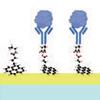| Oct 12, 2025 |
A light-activated graphene and black phosphorus biosensor detects Alzheimer’s biomarkers in blood at zeptomole sensitivity, marking a major advance toward ultra-early, non-invasive diagnosis.
(Nanowerk News) The progression of Alzheimer’s disease begins decades before symptoms appear, leaving a long diagnostic gap that hinders the development of effective treatments. Detecting the disease in its earliest stages has remained one of neuroscience’s toughest challenges.
|
|
Researchers at Shenzhen University and Huazhong University of Science and Technology have now developed a light-triggered biosensor that can detect key Alzheimer’s biomarkers at extraordinarily low concentrations, reaching the zeptomole (zM) level. Their study, published in Research (“Light-Triggered Graphene/Black Phosphorus Heterostructure FET Platform for Ultrasensitive Detection of Alzheimer’s Disease Biomarkers at the Zeptomole Level”), describes a new platform that merges nanomaterial sensitivity with a photonic amplification strategy. The result is a device that could one day enable non-invasive, ultra-early screening for Alzheimer’s risk through a simple blood test.
|
 |
| Schematic diagram of G-BP FET biosensor operation procedure. (A) Schematic diagram of the Aβ42 antigen. (B) Structural and principle diagram of light-triggered G-BP FET. (C) Effect of light on the detection of LOD of Aβ42 protein by the G-BP FET biosensor. In the dark state, the LOD of the G-BP FET biosensor is 2.767 aM. In the light state, the LOD of the G-BP FET biosensor is 235.1 zM. (Image: Reprinted from DOI:10.34133/research.0772, CC BY)
|
|
The new biosensor is built on a two-dimensional heterostructure consisting of a layer of graphene placed over black phosphorus on a silicon substrate. This architecture is central to its performance. Graphene provides a high surface-to-volume ratio and excellent electronic conductivity.
|
|
At the nanoscale, even the faintest electrostatic disturbance, such as that caused by a single biomolecule, can alter the flow of current through the material. The researchers functionalized this graphene surface with antibodies that selectively capture amyloid-beta (Aβ42), one of the hallmark proteins associated with Alzheimer’s disease.
|
|
The device operates through a dual-gating mechanism. The first component, electrostatic gating, registers changes in current when Aβ42 binds to the sensor’s surface. The second, photogating, amplifies that signal. When the sensor is illuminated by light of a specific wavelength, it enters a highly responsive state, producing a stronger electronic signal even at vanishingly small biomarker concentrations.
|
|
“We are using light to create a highly sensitive electronic response,” explained Professor Han Zhang, who led this work. “Under illumination, when a target molecule binds, it generates a distinct signal that we can clearly detect. This synergistic effect is what allows us to push the detection limits for this type of device architecture.”
|
|
Under dark conditions, the sensor detects Aβ42 at 2.767 attomoles per liter (aM). When activated by light, its sensitivity improves dramatically to 235.1 zeptomoles per liter (zM), roughly two to three orders of magnitude lower than other biosensing platforms.
|
|
Current methods for Alzheimer’s diagnosis, such as PET imaging or cerebrospinal fluid analysis, are effective but either expensive or invasive. Blood-based biomarker tests are easier to administer but often lack the sensitivity needed for the earliest stages of disease. By combining light activation with nanomaterial engineering, the G–BP FET biosensor bridges this sensitivity gap. The device can detect molecular signatures associated with Alzheimer’s long before symptoms appear, potentially during the disease’s preclinical phase.
|
|
For now, the researchers have demonstrated the platform’s effectiveness in controlled serum and buffer environments. The team acknowledges that further development is needed before the sensor can be applied in clinical settings, but the early results mark a substantial advance in nanoscale biosensing technology.
|
|
The implications of such sensitivity extend beyond Alzheimer’s diagnostics. The same architecture could, in principle, be adapted to detect a variety of neurodegenerative or oncological biomarkers, offering a pathway to faster and less invasive medical testing. For drug developers, this technology could make clinical trials for preventive Alzheimer’s treatments more efficient by identifying at-risk individuals before irreversible brain damage occurs. For clinicians, it hints at the possibility of routine population-level screening for neurodegenerative disease risk, an idea still far from realization but increasingly within reach.
|
|
The research team is now working to expand the biosensor’s multiplexing capabilities so that it can detect multiple biomarkers simultaneously. “Under illumination, when a target molecule binds, it generates a distinct signal that we can clearly detect,” Zhang said. “This synergistic effect is what allows us to push the detection limits for this type of device architecture.”
|
|
While challenges remain in scaling and validation, the study lays a foundation for a new generation of ultrasensitive, non-invasive diagnostic tools and signals a step forward in the pursuit of early Alzheimer’s detection.
|


